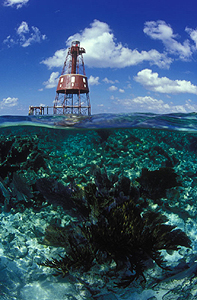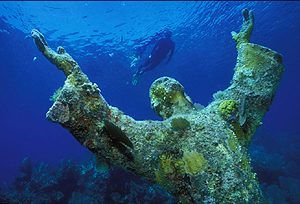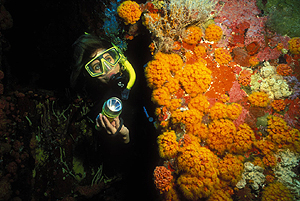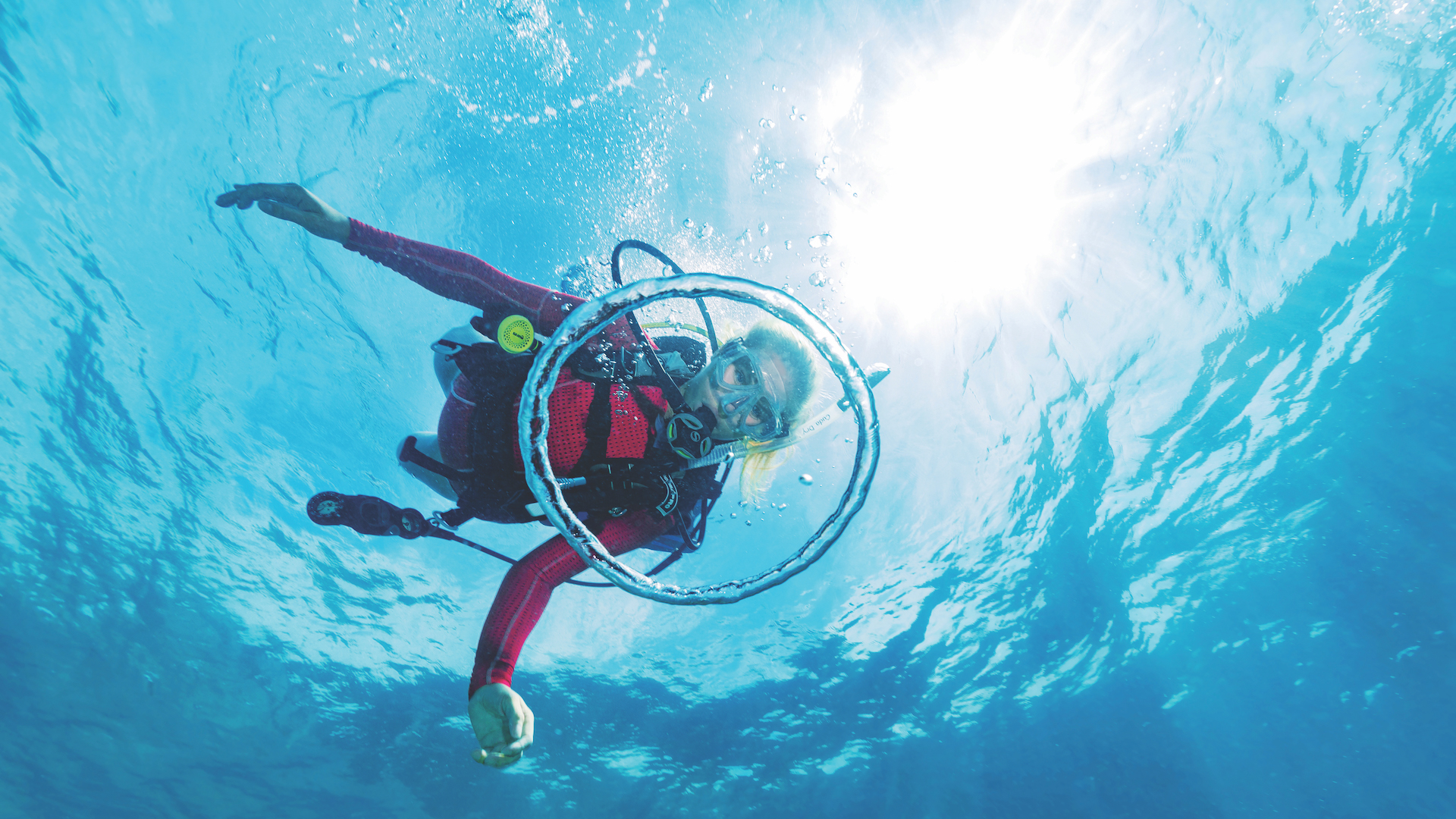Key Largo: A Dive Wonderland
Text and Photography by Stephen Frink©
KEY LARGO — To understand why Key Largo, the northernmost island in the Florida Keys, holds such a revered position in the dive pantheon, it is important first to recognize the role geology has played, beginning in prehistoric times.
Key Largo Geology - In the Pleistocene Epoch, about 1.8 million years ago, the global sea levels dropped due to glaciation at the polar caps and the Florida Keys emerged from the sea. The sea continued to fall, eventually dropping about 350 feet lower than it is today. The shoreline was five to ten miles seaward of the present Keys, and Florida Bay was dry land. Soil and vegetation began to build mature islands from what was once coral reef. Then about 15,000 years ago, the climate began to warm significantly.
 Carysfort Reef - Situated near the northern boundary of the Key Largo National Marine Sanctuary, Carysfort reef was named for a ship that ran aground here in 1770.
Carysfort Reef - Situated near the northern boundary of the Key Largo National Marine Sanctuary, Carysfort reef was named for a ship that ran aground here in 1770.
Terrestrial communities were flooded and new marine habitats developed over fossil corals. The water rose rapidly - about 70 feet per thousand years - until about 10,000 years ago when Earth entered the Holocene Epoch and the rise in seawater stabilized at three feet per thousand years. This rise in sea level reduced the size of the once massive islands that comprised the Florida Keys. Instead of one continuous peninsula connected to the Florida mainland, the Florida Keys became 200 smaller islands, of which Key Largo is the longest. This is how it was in the 1500s when Spanish explorers visited the region and named the island "Cayo Largo," largo meaning long in Spanish.
All of these would be but dry statistics were it not for the island's role in the development of offshore coral reefs. In the words of Dr. Walter Jaap in The Monroe County Environmental Story: "Geography and geology are important to the distribution of the coral reefs off the Florida Keys. Geologists report that Florida's recent reefs came into existence about 6,000 to 7,000 years ago. Sea level was much lower and seawater temperature slightly reduced. About 4,000 years ago, Florida Bay flooded as sea level rose and began to influence the distribution of coral reefs. Since Florida Bay is a shallow basin, climate has a significant influence on its water quality. Heavy rainfall rapidly dilutes salinity. Winter cold fronts chill the water quickly; summer doldrums (periods of very hot weather) increase the salinity through evaporation (water evaporates, salts do not). . . The larger keys form a natural dam that restricts water flow from Florida Bay into the Atlantic Ocean, which in turn affects the distribution of coral reefs. For example, Key Largo is a long key with a single opening from the bay into the Atlantic; reef development seaward of Key Largo is extensive . . . In the region between south Key Largo to Big Pine Key, reefs are not as numerous or as well developed".
The large island blocked the daily tidal flow of turbid and nutrient rich waters from Florida Bay, which fostered the growth of corals. But perhaps as significantly, the reefs off Key Largo happened to be in proximity to the flow of the Gulf Stream, a giant oceanic current flowing from the south bringing a steady supply of clear water, embryonic corals, and pelagic marine life to continually replenish these reefs. Nature had generously provided the mix of elements necessary to assure an underwater wonderland.

Key Largo Coral Reef Conservation - This was the natural state of things until modern times when man discovered the selfish benefits the coral reef could bestow. With the invention of the self-contained underwater breathing apparatus (scuba), spearfishermen learned they could reap boatloads of fish from the prolific reefs of Key Largo. Those in the business of providing the trinkets sold in roadside novelty shops learned they could rip out coral heads with crowbars and shellac puffed balloonfish to provide souvenirs for the tourists. While an accident of geology created the finest coral reef tract in the continental United States, an accident of geography positioned Key Largo as the island nearest the South Florida population center of Miami. This easy accessibility left Key Largo ripe for exploitation.
Fortunately there was a corps of ecological pioneers in South Florida in the late 1950s who realized this underwater gem was in need of preservation. In a stirring presentation at a biological conference held at Everglades National Park in 1957, Dr. Gilbert Voss of the University of Miami eloquently outlined the potential desecration of these reefs and enlisted powerful allies. With the help of the National Audubon Society, the University of Florida, and the Miami Herald under the direction of editor John Pennekamp, the nation's first underwater park was created. On December 3, 1959 the control of the ocean bottom to the three mile limit was transferred to the Florida parks system, and on March 15, 1960 President Eisenhower placed the remaining waters beyond the three mile limit to the edge of the Continental Shelf under the control of the Department of the Interior. John Pennekamp Coral Reef State Park was now a reality and spearfishing and coral collection were prohibited.
The coral reef gained even greater protection in 1975 with the creation of the Key Largo National Marine Sanctuary which brought the resources of the National Oceanic and Atmospheric Administration (NOAA) to bear in the continuing effort for conservation. Mooring buoys were installed to prevent damage from misplaced anchors, and public awareness campaigns stressed the need for diver awareness of buoyancy control to minimize impact with the living coral. The ultimate confirmation of the success of the reef preservation programs off Key Largo occurred in 1990 with the passage of the Florida Keys National Marine Sanctuary and Protection Act. Now, 2,800 square miles of coastal waters surrounding the entire Florida Keys will be protected through the designation of "use zones."
The Dive Infrastructure - The Florida Keys are known as "The Islands You Can Drive To". Located just 50 miles south of Miami, the Keys are accessible by U.S. 1, the Overseas Highway. Key Largo is the first island encountered by a southbound motorist, and by far the greatest dive activity happens here (as might be assumed from the proliferation of red and white diver-down flags that dot the island). However, just because it is easy to get to Key Largo does not mean it is easy to get to the best of the reefs and wrecks offshore. Key Largo, like the rest of the Florida Keys, features a fringing coral reef four to six miles offshore, making quality shore diving impossible and making the dive boat a necessary complement to the Key Largo dive experience.
An impressive local dive industry evolved as a result of this need for servicing visiting scuba divers with air fills, instruction (from resort course all the way through instructor), retail merchandise, specialty activities such as underwater photography, and most notably, boat transportation to the reef. It is often noted that there are more dive shops per square mile on Key Largo than on any island anywhere, so obviously it is not a problem finding transport to the reef on any given day. And since the operation of these commercial dive boats is under the regulation of the U.S. Coast Guard, divers may rest assured that the vessels shall be seaworthy and stable, and their captains and crews competent and experienced.
The Reefs and Wrecks - The coral reefs off Key Largo are both patch reef and a primarily spur-and-groove configuration of bank reef. Most of the patch reefs are three to four miles offshore and offer wonderful snorkel opportunities owing to their shallow depth and profusion of both juvenile and adult marine life. However, most of the scuba activity occurs along the offshore bank reef at depths of 20 to 35 feet. It is along this extensive reef line that the greatest concentrations of coral are found, along with the clearest water and most impressive fish populations. Visibility typically ranges from 25 to 100 feet, with an average water clarity of 50 feet, and a temperature range from 70 degrees Fahrenheit in the winter to a balmy 85 degrees Fahrenheit in the summer.
The most popular dive sites are marked by mooring buoys. More than two dozen can be found on Molasses Reef alone, and others dot a 25-mile stretch of reef line. Some of the Key Largo dive icons include the following coral reefs, from north to south:
Carysfort Reef - Situated near the northern boundary of the Key Largo National Marine Sanctuary, Carysfort reef was named for a ship that ran aground here in 1770. Despite the different spelling, Carysfort was named for the HMS Carysford. Marked by a 112 foot lighted steel tower, the reef features an unusual "double reef" where fire corals, elkhorn, and staghorn corals intermingle with boulder corals in the 15 to 20-foot depth range before gradually sloping to a spur-and-groove that terminates at a sand plateau at 65 feet before rising again to a second offshore reef that tops out at 35 feet and again drops gradually to seaward. Because Carysfort is a far ride for most dive operators, it is relatively infrequently visited, and consequently highly prized by those seeking submarine solitude. At South Carysfort acres of elkhorn corals lie just below the surface providing a fascinating coral maze for both divers and snorkelers.

The Elbow - Named for a reef complex that juts out into the blue waters of the Gulf Stream like a bent arm, the Elbow is popular for both the quality of its coral reef and its historical shipwrecks. Sites like South Ledge Dropoff, the Fingers, and Grunt Gully are renown for their concentrations of bluestriped grunt, angelfish, porkfish, Bermuda chub, and parrotfish. The most famous residents of the Elbow are the tame, green moray eels and barracuda that reside at the wreck of the City of Washington, a coastal freighter that ran aground in 1917. Local dive operators have long fed these normally fearsome predators, conditioning them to the point where they will now take ballyhoo proffered from between a diver's clenched teeth. This is a dangerous activity however, best left to those a little crazy and a lot experienced.
Christ of the Abyss - Recognized as the symbol of Pennekamp Park, the Statue of Christ of the Abyss is a replica of a statue sunk in 1954 in the Mediterranean off Genoa, Italy as a memorial to sailors lost at sea. The 9-foot bronze statue now sits in 25 feet of water at a reef structure known as Key Largo Dry Rocks. It was cast from the same mold as the Italian statue and donated to the Underwater Society of America in 1961 by Egidio Cressi of the Cressi Sub dive equipment manufacturing fame. The Christ statue looks out over a thriving coral reef dominated by a gigantic brain coral and is one of Key Largo's most popular destinations for both divers and snorkelers.
The Benwood - During World War II there was considerable German U-boat activity off the Florida coast, and in attempting to avert the notice of enemy submarines, the Benwood was operating blacked-out, without running lights, when she was rammed by a similarly darkened Robert C. Tuttle. The crew steered the Benwood toward shore in hopes of beaching her before she sank. On April 9, 1942, the Benwood instead became another of Key Largo's wondrous dive sites, this one in just 35 feet of water. Safety officials blew the ship apart to prevent a navigation hazard, but the bow remains relatively intact and harbors a resident school of porkfish amid colorful gorgonia. Huge schools of grunt and goatfish patrol the deck plating, and Christmas tree worms bore their tunnels amid the encrusting fire coral that cloaks the hull.
Molasses Reef - The most frequently visited dive site in the Key Largo National Marine Sanctuary, and likely the world, is known as Molasses Reef. Named for the cargo of a wrecked ship, probably the Slobodna run aground here in 1887, Molasses is typified by huge schools of grunt and gray snapper, the windlass left behind by the Slobodna, and high profile coral heads populated by all manner of Caribbean reef tropical. Some of the fish are not necessarily even Caribbean, for there are a pair of Indo-Pacific batfish (probably aquarium discards) that have for years coexisted with their cousins, Atlantic spadefish. Because Molasses Reef juts out into the cleansing waters of the Gulf Stream, on any given day this reef offers some of the best visibility anywhere in the Florida Keys, and even after having dived Molasses for 18 years, it remains one of my favorite dive sites in the Western hemisphere for fish photography.
The Bibb and Duane - Key Largo is home to plenty of historical shipwrecks but the local dive community had long coveted an impressive modern shipwreck. Finally in 1987 a group of motivated dive operators spearheaded a project whereby a pair of 327 foot retired U.S. Coast Guard cutters were cleaned of all contaminants and towed to a site just south of Molasses Reef where they were sunk as dive attractions. The Duane now rests perfectly upright in 120 feet of water while the Bibb landed on her starboard side in 130 feet of water. Both ships are now colorfully encrusted and attract abundant marine life. The Duane is the more often visited of the two due to her upright posture and shallower depth, but the Bibb is possibly more photogenic owing to her thick coat of colorful gorgonia and hydroid.
The Spiegel Grove Project - The fantastic popularity of the Bibb and Duane for visiting divers spawned another, even more ambitious, project. The 510-foot military vessel Spiegel Grove was donated by the Maritime Administration from its James River Reserve, and after years of arduous work by the Key Largo dive and business community, this mammoth shipwreck was finally cleaned of all potential contaminants, towed to a site 7 miles offshore of Key Largo, and sunk as a dive attraction on June 17th, 2002. For a complete overview of the Spiegel Grove project, click here.
In the months this ship has been on the bottom, she has been attracting fish and divers in similarly massive numbers. The wreck now lies on her starboard side in 120 to 130 feet of water. With 80 feet of beam, her port rail is less than 60 feet below the surface. The ship is so huge that no diver can explore, or even view, most of the ship on a single dive. Dive shops are reporting a significant upswing in divers coming specifically to Key Largo to dive the Spiegel Grove, but once here, they are rediscovering the healthy fish populations and diverse reef structures of this northernmost Florida Key. With Sanctuary Preservation Areas providing complete "no-take" zones throughout the prime dive areas, divers are consistently amazed at not only the sheer quantity of fish, but also their friendly ease of approach.


